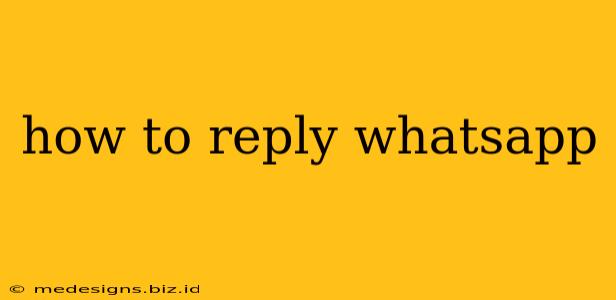WhatsApp has become an indispensable communication tool for billions worldwide. Knowing how to effectively and efficiently reply to WhatsApp messages is crucial for maintaining clear communication and strong relationships. This guide covers various methods and best practices to ensure you never miss a beat.
Understanding WhatsApp Reply Methods
There are several ways to reply to a WhatsApp message, each offering different levels of convenience and functionality. Let's explore them:
1. The Standard Reply:
This is the most basic method. Simply open the WhatsApp chat with the person you want to reply to, and type your message in the text box at the bottom. Hit send (the paper airplane icon), and your message is on its way.
Pro Tip: Use emojis and GIFs to add personality to your replies!
2. Quick Replies:
For frequently used responses, consider using quick replies. While not a built-in feature like on some platforms, you can achieve similar efficiency by:
- Creating canned responses: Prepare short, common replies (e.g., "Okay," "Thanks," "I'll get back to you later") and copy-paste them when needed.
- Using keyboard shortcuts: If your device allows, explore keyboard shortcuts for frequently used words or phrases to speed up typing.
3. Replying to Specific Messages:
When dealing with a long conversation thread, responding to specific messages keeps the conversation organized. Simply tap on the message you want to reply to. A small arrow will appear; tapping it creates a reply chain, clearly indicating which message you're addressing.
This is incredibly useful for:
- Avoiding confusion: It ensures clarity when discussing multiple topics in a single chat.
- Maintaining flow: Keeps the conversation linear and easy to follow.
4. Using Voice Notes and Voice Calls:
Sometimes, typing isn't the most efficient method. WhatsApp allows you to quickly send voice notes or initiate a voice call for a more immediate and personal reply. This is particularly useful when you need to convey complex information quickly or prefer a more conversational approach.
5. Sending Photos and Videos:
WhatsApp is not just for text. You can easily reply with photos and videos directly from your device's gallery. This adds a visual element to your communication and is perfect for sharing experiences or providing visual context.
6. Using Documents and Files:
For more formal or detailed replies, you can send documents (PDFs, Word docs, etc.). This is useful for sharing reports, presentations, or other relevant files.
Best Practices for WhatsApp Replies
- Be Prompt: Aim to respond to messages in a timely manner. A delayed reply can lead to misunderstandings or frustration.
- Be Clear and Concise: Get to the point. Avoid unnecessary jargon or overly long sentences.
- Proofread Before Sending: Check for typos and grammatical errors to maintain professionalism.
- Use Appropriate Language: Tailor your language to your recipient and the context of the conversation.
- Respect Boundaries: Don't bombard people with messages. Be mindful of their time and availability.
Mastering WhatsApp Replies: Enhancing Communication
By mastering these methods and best practices, you can significantly enhance your communication experience on WhatsApp. Effective replies foster stronger relationships, improve efficiency, and leave a positive impression on your contacts. Experiment with different methods to find what works best for you and your communication style. Remember that clear, timely, and considerate replies are key to successful WhatsApp interactions.
